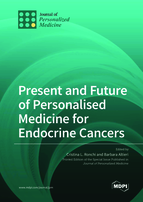Present and Future of Personalised Medicine for Endocrine Cancers
A special issue of Journal of Personalized Medicine (ISSN 2075-4426). This special issue belongs to the section "Mechanisms of Diseases".
Deadline for manuscript submissions: closed (10 February 2022) | Viewed by 27938
Special Issue Editors
Interests: endocrine cancer; neuroendocrine tumours; adrenal tumours; adrenocortical carcinoma; endocrine oncology; molecular pathogenesis; prognostic biomarkers; drug targets; precision medicine
Interests: adrenal tumor; neuroendocrine tumor; genetic syndrome
Special Issue Information
Dear Colleagues,
Major technological advances in genomics have made it possible to identify critical genetic alterations in cancer, rendering oncology well along the path to “personalised cancer medicine”. Thanks to developments in genetics, several mutations and gene rearrangements have been identified in patients with endocrine cancers (e.g., thyroid and adrenocortical carcinoma). In particular, each patient can be considered as a unique, individual one, with unique genetic information. This is particularly important when talking about targeted anticancer drugs that, contrary to standard chemotherapy, aim at one or more definite molecular pathway on cancer cells—so their selection is underlying patient’s genetic information.
The aim of this Special Issue is to offer an overview of exciting new research in the area of endocrine tumours may set the stage for an innovative personalised management and precision medicine modalities for individualised care.
New affordable individual genomic analyses as well as the opportunity to test new compounds in primary cells may allow a personalised management of patients with endocrine malignancies. This approach may improve the prediction of clinical outcome and therapeutic effectiveness, as well as help to avoid the use of ineffective drugs. However, further efforts are needed to obtain an adjustment of clinical management in patients with endocrine cancers that would rely solely or in great part on genetic information.
We are soliciting basic, translational and clinical papers on personalised medicine in endocrine malignancies (i.e., thyroid and adrenal), especially focusing on diagnostic and prognostic biomarkers as well as novel drug targets or targeted treatments, including eventual clinical trials.
Dr. Cristina L. Ronchi
Dr. Barbara Altieri
Guest Editors
Manuscript Submission Information
Manuscripts should be submitted online at www.mdpi.com by registering and logging in to this website. Once you are registered, click here to go to the submission form. Manuscripts can be submitted until the deadline. All submissions that pass pre-check are peer-reviewed. Accepted papers will be published continuously in the journal (as soon as accepted) and will be listed together on the special issue website. Research articles, review articles as well as short communications are invited. For planned papers, a title and short abstract (about 100 words) can be sent to the Editorial Office for announcement on this website.
Submitted manuscripts should not have been published previously, nor be under consideration for publication elsewhere (except conference proceedings papers). All manuscripts are thoroughly refereed through a single-blind peer-review process. A guide for authors and other relevant information for submission of manuscripts is available on the Instructions for Authors page. Journal of Personalized Medicine is an international peer-reviewed open access monthly journal published by MDPI.
Please visit the Instructions for Authors page before submitting a manuscript. The Article Processing Charge (APC) for publication in this open access journal is 2600 CHF (Swiss Francs). Submitted papers should be well formatted and use good English. Authors may use MDPI's English editing service prior to publication or during author revisions.
Keywords
- endocrine tumours
- biomarkers
- diagnostic markers
- prognostic markers
- targeted treatment
- drug targets
- endocrine oncology
- precision medicine








